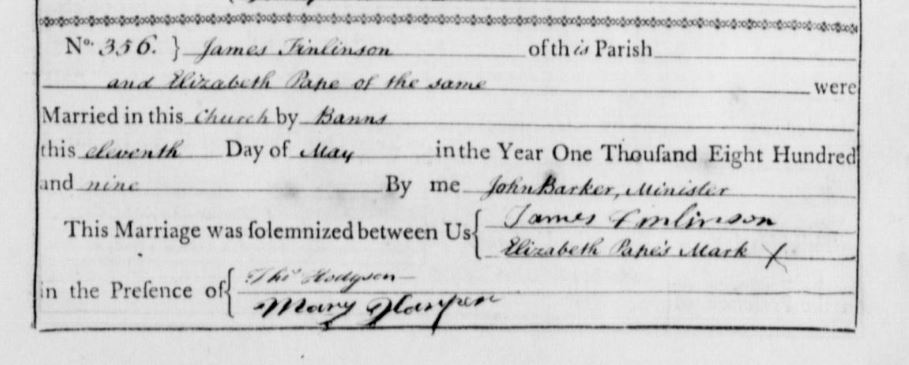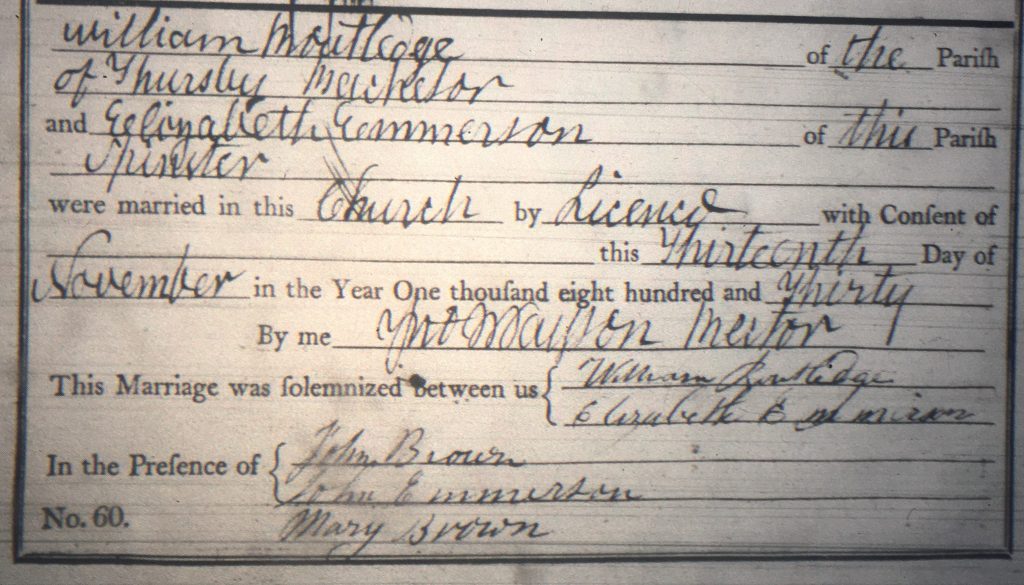The puzzle of the several James Finlinsons and their Occupations
Every now and again in the poor law vouchers we come across an unusual surname and think that this would be a good person to research, based on the belief that the more unusual the surname, the easier they will be to locate in the records. All too often, we find the sources confusing with more than one person sharing the same name. What follows is about two people sharing the name James Finlinson who had a tendency to move around a great deal.
One James Finlinson (1783-1847),was a man pre-occupied with parochial office becoming Governor of the Workhouse, Assistant Overseer, Registrar, Surveyor and Manager of Roads for the parish of Dalston. Despite his accumulation of posts, James has been somewhat of a difficult person to trace especially before his appointment as Governor of the Workhouse in 1825. He and his wife, Elizabeth’s (1784-1869) association with the poorhouse lasted for many years.
In 1825 James and Elizabeth were appointed as Governor and Matron of Dalston Workhouse with the salary of £14 per annum and a room for a loom. In 1826 a new workhouse in Dalston was built. On 26 April 1827 James was appointed assistant overseer of the poor for Dalston with a salary of £13 and keeper of the workhouse with an additional of £12.
In the Militia List, Cumberland Ward, for 1818, is a James Finlinson, weaver, aged 32, of Buckabank. Given his occupation, this is likely to be the same Finlinson who became the workhouse governor.
Finlinson is one of those people whose association with parochial office spanned the old poor law and the changes brought about by the 1834 Poor Law Amendment Act. In 1843 he was appointed as manager of the roads and in November 1844 resigned as Overseer.
He was reappointed Overseer in February 1845.
Dalston Vestry minutes of 1844 show that Finlinson’s offer regarding Dalston workhouse was resolved. Rent of £6 10s per annum was accepted for part of the workhouse, including the kitchen, vestry room, lodging room above vestry room, the garden and one out building.
James’ parents were James Finlinson, yeoman, of Houghton and Ann [Nancy] Corry who were married by licence on 30 October 1779 at St Michael’s, Stanwix, (licence granted 24 October 1779). At the time their first child John was baptised at Stanwix 28 October 1781, James and Ann were living at Pepper Moss. John went on to marry Mary Wood, and became a farmer at Warblebank Westward.
James was baptised at Bolton parish church, Cumberland, in 1783. Other children followed: Sarah, baptised 24 July 1785; Ann baptised 6 March 1791, both at Bolton. Joshua, son of James Finlinson of Little Dalston, husbandman, and his wife Ann late Corry, was baptised 11 June 1797 at Dalston.
Joshua became a blacksmith and parish clerk in Thursby. He is buried in Thursby churchyard. Also buried in Thursby churchyard are James (d.23 February 1834, aged 81), and Ann (d.20 February 1824, aged 70).
James Finlinson the younger, married Elizabeth Pape on 11 May 1809 at St Mary’s, Kingston-upon –Hull, by banns.

Why they married in Hull is a mystery.
One theory is that James was serving in the Military, but no mention of James has been found in Military records.
Elizabeth was baptised in Mordon, Sedgefield, County Durham, on 18 December 1784. Her parents were Robert Pape, a cordwainer, and Ann. The family moved to Whitby, Yorkshire, where a daughter, Ann, was born on 10 January 1789 (baptised 13 January 1789 at St Mary the Virgin, Whitby). Robert Pape was buried in the same church on 20 October 1812, aged 63.
In the 1841 no occupation for James or his wife Elizabeth is stated. In their household is a William Finlinson, aged 15, who most likely was the son of Joshua blacksmith of Thursby.
James died on the 25 November 1847. He is buried in Dalston churchyard. The inscription on his grave reads:
In Memory of James Finlinson many years assistant overseer for this parish,
who died Nov. 25th 1847, aged 65 years
Also Elizabeth, his wife,
Who died November 13th 1869, Aged 85 years.
This stone was erected
By the members of the Loyal Caldew Lodge,
Dalston, of the Independent Order of Oddfellows, M.U.,
As a token of respect for his valuable services
After his death, although this has not been determined for certain, it seems that Elizabeth continued to live in what was the Poorhouse for a while. In both the 1851 and 1861 Censuses she had her sister Ann were living at the Forge, Buckabank. Her occupation was given as laundress and that of her sister as a boot binder.
One of the other James Finlinsons in the area was a schoolmaster. He also had a wife Elizabeth. James married Elizabeth Shepherd on 5 September 1796 at St George’s, Bloomsbury, London. This James and Elizabeth Finlinson certainly had two children baptised Helen (25 January 1804) in Wigton, and Joshua in Penrith (6 June 1807) who went on to become a Church of England clergyman.
There were also three daughters of a schoolmaster James Finlinson and Elizabeth Finlinson who were baptised on 20 October 1814 at St Mary’s Carlisle, but, despite the title ‘schoolmaster’, it is not certain yet as to which James and Elizabeth were their parents.
Sources
Dalston Memorial Inscriptions, p.79 No. 224
Parson and White, Directory of Cumberland 1829, p. 372, James Finlinson Governor of the Workhouse
Mannix and Whellan Directory of Cumberland 1837, p.193, James Finlinson Registrar Dalston
James Finlinson entries in the Carlisle Journal and Carlisle Patriot:
Unless there is reference in the newspaper articles to Dalston, it is difficult to determine to which James Finlinson they refer
Carlisle Journal 5 Jan 1811
Advert for Pupils J Finlinson Grove House near Wigton
Carlisle Journal 17 Aug 1811 p.1 col.D
Letting of farm at Bog-Hall Bolton parish near Wigton.
James Finlinson was owner & occupier of the estate
Carlisle Journal 27 Nov 1819
Letters to the Carlisle newspapers regarding a dispute over recording a County meeting. James Finlinson was said to be an obscure schoolmaster of Carlisle
Carlisle Patriot 8 Jan 1820
Private Tuition offered to inhabitants of Carlisle by J Finlinson
Carlisle Journal, 19 May 1838 p.3, col. D.
Correspondence with a Mr J Routledge of Brampton regarding Jane Hall a pauper belonging to the parish of Cumwhitton
Carlisle Journal 26 Feb 1842 p.1 col. B
Nominations for Election of Guardians of the Poor James Finlinson for Dalston
Carlisle Journal, 5 March 1842, p.1, col. E
Nominations for Election of Guardians of the Poor James Finlinson for Dalston
Carlisle Journal, 7 May 1842, p.1, col. A
Notice of order of road diversion Barras Lane Dalston. James Finlinson Surveyor of the Parish of Dalston.
Carlisle Journal, 27 April 1844, p.3, col. C
Alterations to Highway at Hawksdale James Finlinson surveyor
Carlisle Journal, 20 July 1844, p.3, col. C
Poilce Intelligence case of John Cairns false entry of birth J Finlinson overseer & registrar
Carlisle Journal, 10 August 1844, p.3, col. H
Under reports from the Cumberland Assizes
James Finlinson assistant overseer for Dalston witness in case of George Cairns who was prosecuted for obtaining money under false pretences from the registrar of births deaths & marriages for Dalston district.
Carlisle Journal, 27 February 1846, p. 1, col. D
Election for the Guardians of the Poor James Finlinson for Dalston
Carlisle Journal, 6 March 1847, p.1, col. F
Notice of Appoint of Joseph Shields of Buccabank as Deputy Registrar to James Finlinson
Thanks to Margaret Dean, and Bob Nichols for their help.

